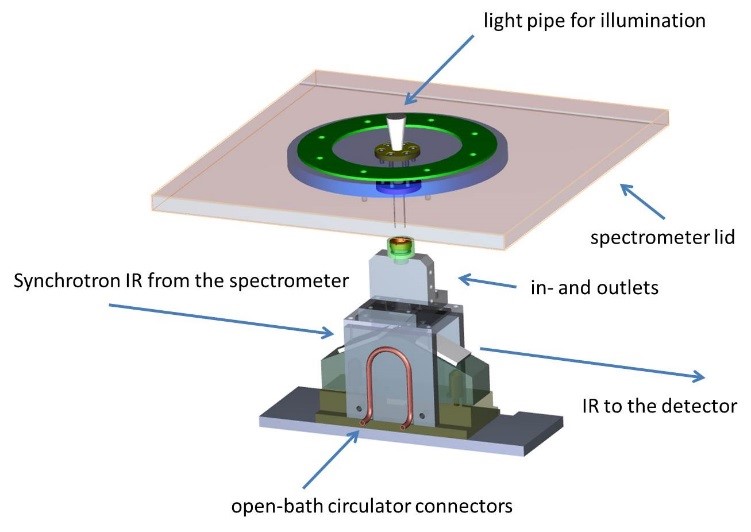Institute for Electronic Structure Dynamics
In Situ and in Operando ATR Investigations of the solid-liquid interface
We aim to study by means of infrared spectroscopy the realistic conditions within a photo- or electrochemical cell, for instance those present in a water-splitting process. These investigations are possible with an ATR-based operando spectro-electrochemical cell currently under development. The cell operates in the vacuum environment of a Bruker Vertex spectrometer at the IRIS beamline. Several ATR crystals (ZnSe, Ge, Si) are available for the cell and allow for measurements from the far- to the mid- infrared spectral range. For electrochemical investigations the ATR crystals will be coated with a nominal 10 nm thick layer of Au to establish an electrode. Photocatalytic reactions can be triggered by illuminating the interface with light of suitable photon energy. The cell can be operated in a temperature between -10 and 90° C by means of an open-bath circulator. All internal materials have been chosen to stand extreme pH-value situations. The cell has several ports suitable for in and outlets for electrolytes or atmospheres, for electrodes and counter electrodes and light. Polarization-modulation (PM) and ellipsometric evaluations are also possible in order to improve the sensitivity at the interface.
Although not in its final stage, the cell has successfully been employed to study for example the hydrogen bond network around hydrogenated nanodiamonds, to derive the dielectrical function of a suite of energetic liquids in the far infrared and also to investigate the light activation of photocatalysts.
References:
- J. Beckmann, B. Marchetti, L. S. von Chrzanowski, E. Ritter, L. Puskar, E. F. Aziz, and U. Schade, Optical Constants of Harmful and Highly Energetic Liquids for Application to THz Screening Systems, IEEE Transactions on Terahertz Science and Technology 6 (2016) 396-407 https://doi.org/10.1109/TTHZ.2016.2547319
- T.Petit, L.Puskar, T.Dolenko, S. Choudhury, E. Ritter, S. Burikov, K. Laptinskiy, Q. Brzustowski, U. Schade, H. Yuzawa, M. Nagasaka, N. Kosugi, M. Kurzyp, M. Venerosy, H. Girard, J. Arnault, E. Osawa, N. Nunn, O. Shenderova, E. Aziz: Unusual Water Hydrogen Bond Network around Hydrogenated Nanodiamonds, The Journal of Physical Chemistry C 121 (2017) 5185-5194 https://doi.org/10.1021/acs.jpcc.7b00721
- J-J. Velasco-Velez, M. Hävecker, A. Knop-Gericke, C. Schwanke, L. Xi, K.M. Lange, J. Xiao, M.F. Tesch, R. Golnak, T. Petit, L. Puskar, U. Schade, M. Borgwardt, I. Kiyan, R. Seidel, and Emad F. Aziz: Multiscale Photon-Based Spectroscopies for In-Situ and In-Operando in Time and Energy Landscape, Synchrotron Radiation News, 30, 2, (2017) 14-19
- A. Bande, I. Bravić, C. B. Minnich, L. Puskar, E. Ritter, U. Schade, E. F. Aziz: Isomeric xylene molecules in the terahertz-far infrared regime: Computational chemistry and spectral modeling view, Vibrational 92 (2017) 220-229 https://doi.org/10.1016/j.vibspec.2017.06.008

